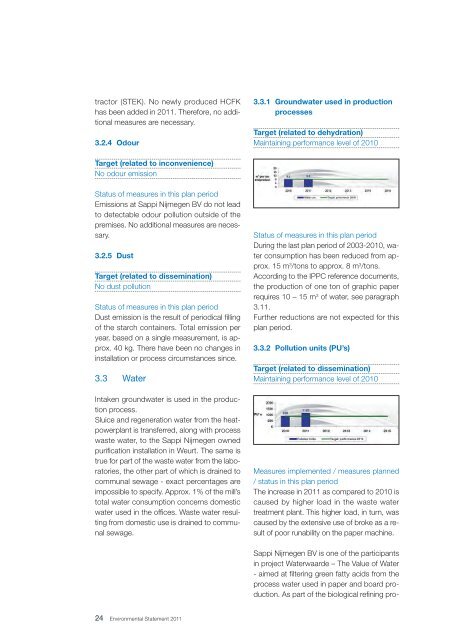2011 Environmental Statement 1.8 MB - Sappi
2011 Environmental Statement 1.8 MB - Sappi
2011 Environmental Statement 1.8 MB - Sappi
Create successful ePaper yourself
Turn your PDF publications into a flip-book with our unique Google optimized e-Paper software.
tractor (STEK). No newly produced HCFK<br />
has been added in <strong>2011</strong>. Therefore, no additional<br />
measures are necessary.<br />
3.2.4 Odour<br />
Target (related to inconvenience)<br />
No odour emission<br />
Status of measures in this plan period<br />
Emissions at <strong>Sappi</strong> Nijmegen BV do not lead<br />
to detectable odour pollution outside of the<br />
premises. No additional measures are necessary.<br />
3.2.5 Dust<br />
Target (related to dissemination)<br />
No dust pollution<br />
Status of measures in this plan period<br />
Dust emission is the result of periodical filling<br />
of the starch containers. Total emission per<br />
year, based on a single measurement, is approx.<br />
40 kg. There have been no changes in<br />
installation or process circumstances since.<br />
3.3 Water<br />
Intaken groundwater is used in the production<br />
process.<br />
Sluice and regeneration water from the heatpowerplant<br />
is transferred, along with process<br />
waste water, to the <strong>Sappi</strong> Nijmegen owned<br />
purification installation in Weurt. The same is<br />
true for part of the waste water from the laboratories,<br />
the other part of which is drained to<br />
communal sewage - exact percentages are<br />
impossible to specify. Approx. 1% of the mill’s<br />
total water consumption concerns domestic<br />
water used in the offices. Waste water resulting<br />
from domestic use is drained to communal<br />
sewage.<br />
24 <strong>Environmental</strong> <strong>Statement</strong> <strong>2011</strong><br />
3.3.1 Groundwater used in production<br />
processes<br />
Target (related to dehydration)<br />
Maintaining performance level of 2010<br />
Status of measures in this plan period<br />
During the last plan period of 2003-2010, water<br />
consumption has been reduced from approx.<br />
15 m 3 /tons to approx. 8 m 3 /tons.<br />
According to the IPPC reference documents,<br />
the production of one ton of graphic paper<br />
requires 10 – 15 m 3 of water, see paragraph<br />
3.11.<br />
Further reductions are not expected for this<br />
plan period.<br />
3.3.2 Pollution units (PU’s)<br />
Target (related to dissemination)<br />
Maintaining performance level of 2010<br />
Measures implemented / measures planned<br />
/ status in this plan period<br />
The increase in <strong>2011</strong> as compared to 2010 is<br />
caused by higher load in the waste water<br />
treatment plant. This higher load, in turn, was<br />
caused by the extensive use of broke as a result<br />
of poor runability on the paper machine.<br />
<strong>Sappi</strong> Nijmegen BV is one of the participants<br />
in project Waterwaarde – The Value of Water<br />
- aimed at filtering green fatty acids from the<br />
process water used in paper and board production.<br />
As part of the biological refining pro-

















